Harley-Davidson motorcycles are iconic machines known for their distinct style and engineering. Determining which front end you have—whether it’s a Sportster front end, a Harley narrow glide front end, or another type of Harley-Davidson front forks—can still be problematic. Especially with older bikes, many parts of the forks may have been changed to different styles or replaced with aftermarket motorcycle parts, making identification more challenging.
In this article we share photos and identifying characteristics for a variety of front ends found on Harleys. Use the photos below and take a look at our guide on Harley-Davidson model codes to help differentiate which front end you have on your Harley Big Twin or Sportster.
Harley-Davidson Fork Types - A Comprehensive Journey
Harley-Davidson has a long-standing tradition of innovative fork designs, each offering a distinct blend of style and performance. Today, many modern models utilize Harley-Davidson front forks engineered by Showa—often referred to as showa forks Harley among enthusiasts. Below are some of the main types you should know:
Springer Forks
The harley springer forks are a vintage design that uses a spring suspension system instead of hydraulic dampening. They feature a pair of springs mounted above the front wheel and a set of rocker arms that allow the fork to compress and rebound. Known for their classic and retro appearance, Springer forks provide a distinct look that harkens back to early motorcycle designs. Commonly found on older models and certain modern retro-styled bikes.
Girder Forks
Girder forks utilize a series of linkages and rigid elements rather than telescopic tubes. They often have a distinctive triangular shape with a pivot point near the handlebars. Girder forks provided a unique aesthetic and were an early solution for front suspension before telescopic forks became standard. Mostly seen on custom and vintage motorcycles.
Hydraulic Forks
Hydraulic forks are the most common type of front suspension used on modern motorcycles. They consist of telescopic tubes with internal springs and hydraulic fluid to dampen shocks. These forks offer a smoother and more controlled ride, with adjustable preload and damping settings on some models. Standard on most modern Harley-Davidson motorcycles, including touring, cruising, and sport models. To protect the fork tubes from dirt, debris, and wear—especially on older models like Sportsters—a Fork Boot Gaiter Set for Harley Sportster's is a simple yet effective upgrade that enhances both performance and longevity. This design is especially common if you have a sportster front end.
WHAT ARE THE PARTS OF HARLEY-DAVIDSON MOTORCYCLE FORKS?
There are multiple types of motorcycle forks, and many components. For the general purpose of this article we will focus on the main components of forks found on Harleys over the years.

Here's a basic diagram of components that make up a motorcycle front end.
- Triple trees: The triple trees (also known as yokes) hold the fork tubes (which contain the fork springs), and are fastened to the neck of the frame by the steering stem.
- Sliders : At the bottom of the fork tubes are the lower legs, often referred to as sliders. The sliders house the dampening assemblies, which vary based on the brand and type of fork.
- Axle: The front axle is located perpendicular and engages the sliders.
- Steering stem: The steering stem connects the center of the upper and lower triple tree, which in turn holds the forks.Harley-Davidsons typically have a 1" outside diameter steering stem. 1977 & earlier Sportsters had a 7/8" stem, which was changed to 15/16" for 1978-1981. After 1981 all Sportsters had a 1" steering stem, including all 39mm Narrow Glide forks.
- Fork tubes: The size of a fork—“39mm” or 41mm, for instance—refers to the outside diameter of the fork tubes themselves. Modern Harley-Davidsons tend to have much larger-diameter fork tubes than earlier models, with 49mm being a common size. Typically, the larger and heavier the motorcycle, the more heavy-duty, and thus larger in diameter, the fork tubes and entire fork assembly.
COMMON HARLEY-DAVIDSON FORKS TYPES & HOW TO IDENTIFY THEM
Having explored the core components that make up Harley-Davidson front ends—such as triple trees, sliders, and fork tubes—we can now appreciate how each element contributes to the bike’s overall handling and style. To truly understand these differences, let’s step back in time and examine how Harley-Davidson fork designs have evolved, from smaller-diameter drum-brake setups to more robust configurations in later models. This historical perspective reveals not only the engineering milestones behind each fork size but also the practical benefits that continue to influence today’s riders and custom builders alike.
The 33.4mm Forks
Early Sportsters had a 33.4mm (actually 1.312" diameter, which converts to 33.325mm) front end, which are easy to identify by their drum brake.
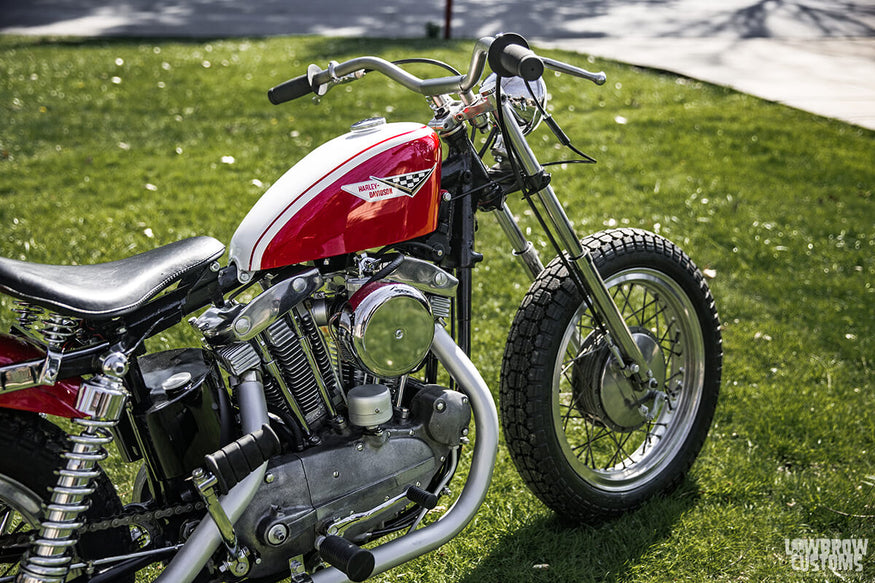
Todd Muller’s Harley Sportster Ironhead features a 33.4mm, drum brake front fork, paired with a carefully selected motorcycle tire size for optimal performance.
The 35mm Kayaba forks
After the 33.4mm forks, the 35mm Kayaba forks were introduced—an upgrade that provided a single disc brake, clearly improving on the older drum style. Although these forks are smaller in diameter than many modern Harley Davidson forks, they remain popular for custom projects and restorations.

Tim Fiorucci of Fiorucci Fabrications built this 1973 Harley Ironhead Sportster Chopper using Harley Davidson Sportster forks in the 35mm Kayaba style, staying true to what the stock bike would have featured.
The 35mm Showa forks
The Kayaba forks were only around a few years until the 35mm Showa forks became the stock front end found on Harley Sportsters and FX models. The 35mm Showa forks come in both single and dual disc brake versions.
The 39mm Narrow Glide forks
39mm Narrow Glide forks are produced by Showa (the same brand that supplied the earlier 35mm forks), and they were fitted on Harley-Davidson Sportsters as well as some Big Twin models such as FXRs, starting in 1987. This type of Harley narrow glide front end maintains a tighter fork spacing, giving the motorcycle a sleek look and agile handling.
 Anna Moore's Evo Harley Sportster has a Showa 39mm Narrow Glide front end.
Anna Moore's Evo Harley Sportster has a Showa 39mm Narrow Glide front end.
The 41mm 'Wide Glide' Forks
Harley Big Twins had 41mm 'Wide Glide' front ends for many years, though current late-model Big Twins now have 49mm fork tubes. Early 41mm Wide Glide forks (1949-1971) had drum brakes, though 1972 on up had disc brakes.
 Kerry Sayre on his Harley Panhead Chopper with a 41mm Wide Glide front end.
Kerry Sayre on his Harley Panhead Chopper with a 41mm Wide Glide front end.IDENTIFY HARLEY FORK TUBES FOR CUSTOM FORK VARIATIONS
The distance between the fork tubes varies across different front ends and Harley-Davidson models, determined by the center-to-center spacing of the triple trees. The term narrow glide front end refers to a closer fork tube spacing, whereas a wide glide front end (often a 41mm Harley forks setup) is typically found on Big Twin models.
There is also a mid glide front end, where the fork spacing sits between narrow and wide. For example, a 39mm Mid Glide fork is found on Harley-Davidson Sportster Forty-Eight models from 2010 to 2015.
The Harley-Davidson Sportster 48 comes stock with a mid glide front end, showcasing unique spacing that sets it apart from standard narrow or wide glides.
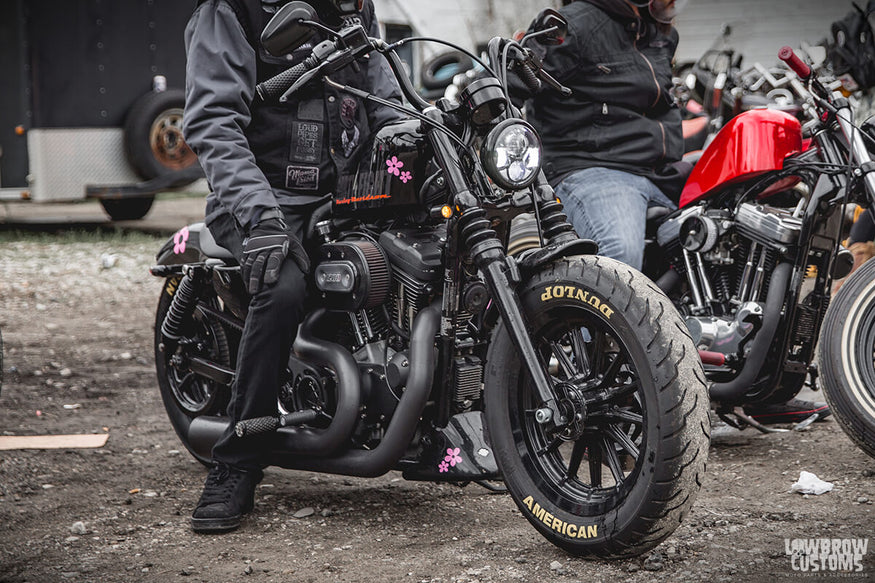 The Harley-Davidson Sportster 48 has a Mid Glide front end.
The Harley-Davidson Sportster 48 has a Mid Glide front end.
Note that with custom Harley parts, or machining of stock parts, you can build a front end that combines non-standard fork tube diameters and widths. Note that this changes the width of axle needed, as well as wheel spacers. It will also affect the spacing of the brake caliper(s) to the brake rotor, as the brake caliper is mounted to the fork slider and will move inward or outward with different fork tube spacing.
An example of a front fork made from modified stock parts is boring 39mm Narrow Glide triple trees to accept 41mm (wide glide) fork tubes. Aftermarket, narrow triple trees are also available for a skinny, chopper front end. Many options exist for wide glide, mid glide and narrow glide triple trees that accept various size fork tubes, allowing many custom fork variations.
Harley-Davidson Fork Tube Center-To-Center Dimension |
|
|
Style Name |
Fork Tube Center-To-Center Dimension |
|
Narrow Glide front end |
7.000" |
|
Mid Glide front end |
8.437" |
|
Wide Glide front end |
9.875" |
Harley-Davidson Fork Tube Diameter Chart by Year Ranges |
|||
| Year Range | Models | Fork Tube Diameter | Brake |
|
1949-1971 |
Big Twins (FL, etc.) | 41mm | Drum |
| 1972-2005 |
|
41mm | Disc |
| 2006-up | Many Big Twins (FXDB, FXDI, FXDCI, FXD35, FXDWGI) | 49mm | Disc |
| 1957-1972 | Sportster, 71-72 FX Super Glide | 1.312" (33.4mm) | Drum |
| 1973-1975 | Sportster & FX, etc. (Kayaba) | 35mm | Disc |
| 1975-1986 | Sportster & FX, FXE, FXR etc. (Showa) | 35mm | Disc |
| 1987-up | Sportster, Seventy-Two, FXR, FXLR etc. | 39mm | Disc |
| 2010-2015 | Sportster Forty-Eight | 39mm | Disc |
| 2016-up | Sportster Forty-Eight | 49mm | Disc |
Harley-Davidson 39mm Fork Tube Length Chart by Year Ranges |
||||
| Year Range | Sportster Model | OEM # | Fork Tube Diameter | Fork Tube Length |
| 1986 Late - 1987 | 883 & 1200 Standard, 883 Deluxe, 883 Hugger | 45407-86 | 35mm | 23.25" |
| 1988 - 1991 | 883 & 1200 Standard, 883 Deluxe, 883 Hugger | 45381-87 | 39mm | 23.375" |
| 1992 | 883 & 1200 Standard, 883 Deluxe | 45381-87 | 39mm | 23.375” |
| 883 Hugger | 45395-92 | 39mm | 24.25" | |
| 1993 | 883 & 1200 Standard, 883 Deluxe | 45381-87 | 39mm | 23.375" |
| 883 Hugger | 45395-92 | 39mm | 24.25" | |
| mid-1993 - 1996 | 883 & 1200 Standard, 883 Deluxe, 883 Hugger | 45395-92 | 39mm | 24.25" |
| 1997 | 883 & 1200 Standard, 883 & 1200 Custom | 45395-97 | 39mm | 23.375" |
| 883 Hugger | 45395-92 | 39mm | 24.25" | |
| 1998 | 883 & 1200 Standard | 45395-97 | 39mm | 23.375" |
| 883 & 1200 Custom, 883 Hugger | 45395-92 | 39mm | 24.25" | |
| 1999 - 2003 | 883 & 1200 Standard, 883 & 1200 Custom | 45395-97 | 39mm | 23.375" |
| 883 Hugger | 45395-92 | 39mm | 24.25" | |
| 2002 - 2003 | 883R | 45395-97 | 39mm | 23.375" |
| 2004 - 2018 | Sportster | 46218-05, 45395-09 | 39mm | 24.8" |
Identifying narrow glide or wide glide front ends on Harley-Davidson motorcycles is crucial for enthusiasts, mechanics, and custom builders. These distinctive forks enhance stability, handling, and aesthetics. Recognizing the differences between wide glide and other front ends is invaluable for repairs, upgrades, and appreciating Harley-Davidson's engineering legacy.
Now you know the details and the basics of how to identify Harley forks, maybe it’s time to get into work. Follow our awesome how-to guides below to understand more about Harley’s front end.
- How to customize a Harley Narrow Glide 39mm front end
- Easy Install: 39mm Fork Shrouds on Harley-Davidson Sportster
- How to install a 39mm Burly Fork Lowering Kit on Harley-Davidson XL Sportster
For high-quality forks, check out Lowbrow Customs. With this guide and our resources, you can confidently identify a Wide Glide front end and understand its significance. Happy riding and wrenching!
FORK IDENTIFICATION PHOTOS
33.4mm Fork Identification
The 33.4mm (1.312") fork was stock on Harley K-models (the predecessor of the Sportster), Sportsters, and early Superglide (Big Twin) models until about 1972. These forks were all drum brakes, and the sliders are steel.
35mm Kayaba Fork Identification Photos



35mm Showa Single Disc Brake Fork Identification Photos
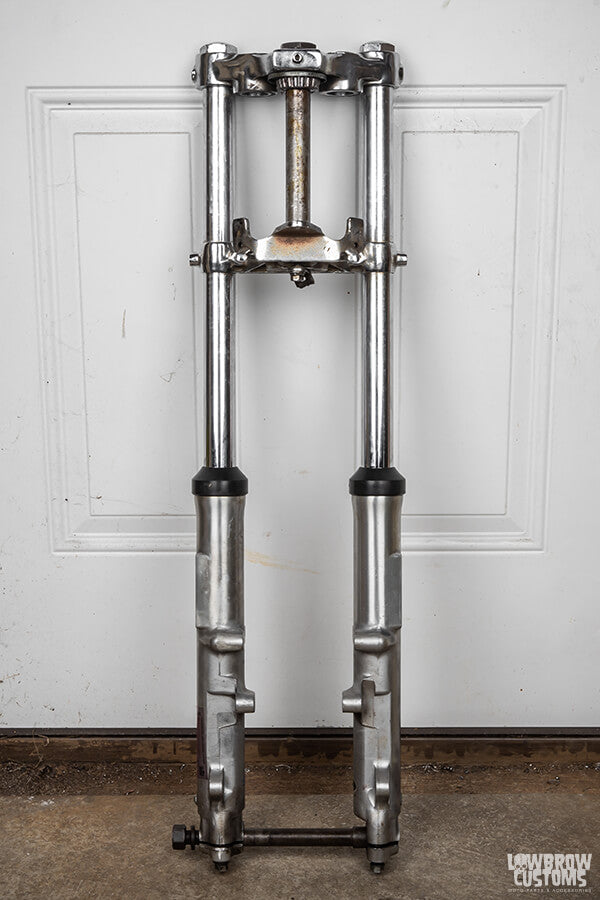


35mm Showa Dual Disc Brake Fork Identification Photos




39mm Narrow Glide Showa Fork Identification Photos

Note: the front end in this photo has longer-than-stock fork tubes
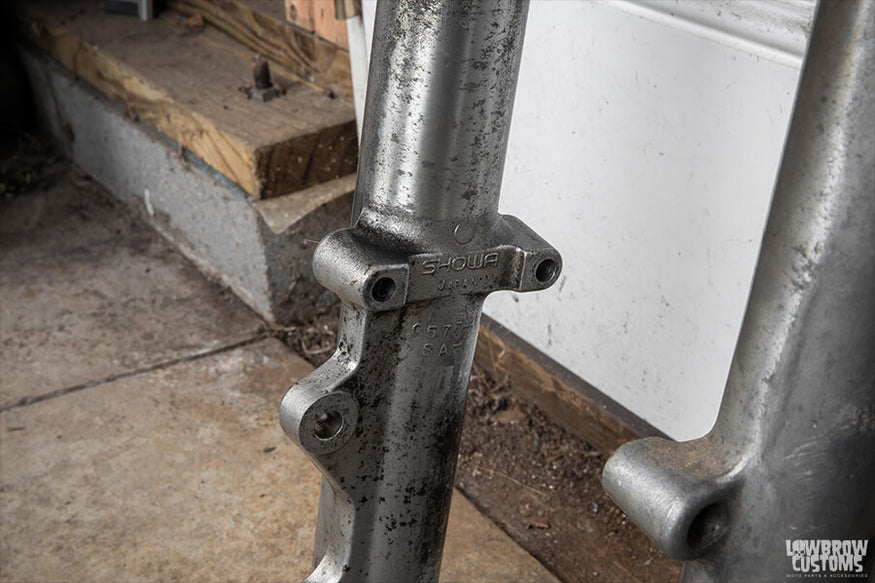
Wide Glide Fork Identification Photos



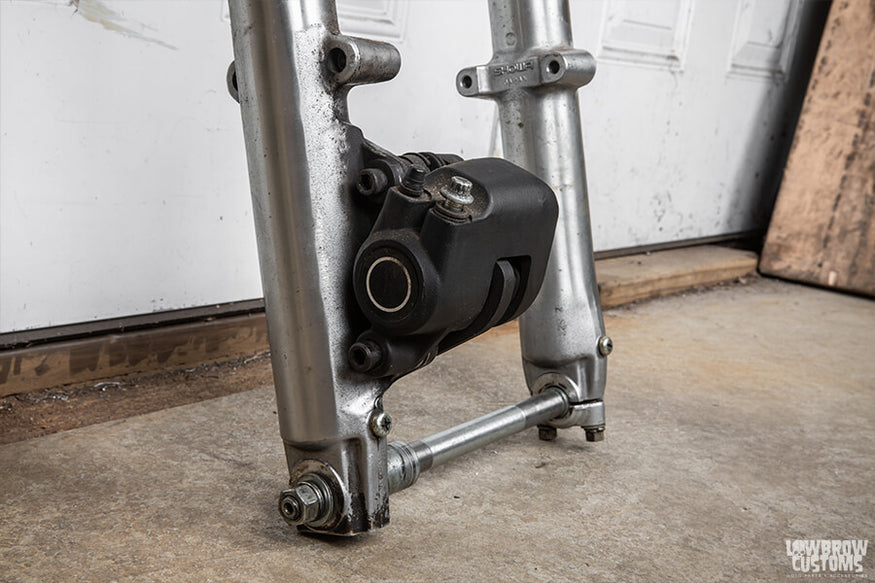
More Photo Examples Of Various Harley-Davidson Forks

Christian Newmans Harley Sportster chopper with customized Showa 39mm Narrow Glide front end. Photo by: David Carlo.

Josh Kohn's Magnum at Fuel Cleveland with 35mm front end, which would have originally been found on a Sportster or FX model Harley. Photo by David Carlo.

Nick Barkley's Harley has a 41mm Wide Glide front end. Photo by David Carlo.

Rob Hultz Shovelhead with a 41mm Wide Glide front end. Note how different a Wide Glide can look depending on the length of the fork tubes. Photo by David Carlo.
Related Products
















